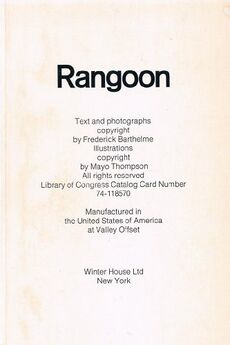Rangoon

A novel by Frederick Barthelme, illustrated by Mayo Thompson. Published in 1970 by Winter House Ltd.
Background
Houston Chronicle
August 30, 1970
The Barthelmes, Houston's Own Hardy Boys
[...] Frederick Barthelme, is 27, an artist and the author of a just-published book of short fiction pieces, "Rangoon." (Winter House $7.95). Another book will be published soon by Doubleday.
[...] His first book, "Rangoon," is the first book to be published by Winter House, a publishing company formed by Laurence Dent and his wife. Dent says that "Rangoon" is a modernization of Joyce, Camus and Stein. According to Frederick Barthelme, its central thesis is "the thunderous acceptability of the human lack of condition."
Contents
| Title | pg. |
|---|---|
| North American homes | 1 |
| OPO: more girl | 11 |
| Regular everything | 22 |
| Mr. and Mrs. Frank Future | 36 |
| But.. | |
| Metasensorialism and extralogic (For J. K.) | 52 |
| A short decade of emotions | 55 |
| The Richard Widmark nets | 67 |
| Dear Blue Alert Captain | 72 |
| The chair | |
| On the availability of proof, circa 1967 | 93 |
| The patrolman's signature | 117 |
| Bark, arf | 122 |
| Gregory Park | |
| Theories of universe | 147 |
| Monitor | 156 |
| Some plumbing | |
| 90° | |
| Peru | |
| Babs | |
| Great ideas in modern geography: Making things plural: Hotels and motels: Optional positivism: Hollywood paneling: Innocent citizens: How to enter tents ... | 181 |
| Sport-mated |
Illustrations
Reviews
| Date | Publication | Author | Link | |
|---|---|---|---|---|
| Spring 1972 | Prairie Schooner: Vol. 46, No. 1 | JSTOR (requires login) | ||
| Library Journal | Dorothy Nyren | Archive.org | ||
| 2003 | pg.5-7 | John Calvin Hughes | ProQuest |
Prairie Schooner
Spring 1972[1]
Rangoon, by Frederick Barthelme with illustrations by Mayo Thompson (Winter House Ltd.), is a relatively expensive ($7.95) put-on that, in its best moments, approaches Mad Magazine at its worst. The written text ranges from unentertaining short fictions to a half-page outline on logical and extralogical reasoning. Interspersed with the written text are three solid black leaves, a group of blurry photos of inconsequential scenes, and some popart drawings that are sometimes related to the text and sometimes interesting. I resent this book not because it is a put-on (to suggest that it is the author's best would be too insulting), but because it is not even a clever put-on.
Library Journal
1970s[2]
Dorothy Nyren
Rangoon is a miscellany of surrealistic short fiction, drawings, and photographs whose themes seem to be the banality of America and an acceptance of the intrusions of technology into daily life. Some blank black pages in the middle are restful. There's one blurred picture of Brooklyn Bridge that's sort of poetic. As for the stories, well, probably one isn't supposed to read them; they are more turn-the-page found objects. The book itself is an example of the intrusion of technology, its banality too banal. For the library that wants everything.
Interpretations
- Barthelme: My first two books, Rangoon and War & War, came out of the world of visual art. I liked the "book" as a container. I was interested in Daniel Spoerri's Anecdoted Topography of Chance (since renamed, I believe). My first two are hard to read now, in part because my literary interests were minimal, in part because they're often clumsily written and adolescent and in part because plastic art ideas didn't translate very comfortably to the literary form. In defense of these books, I can say that a lot of people have done the same things a lot better since.[3]
References
- ↑ https://www.jstor.org/stable/40629130
- ↑ https://archive.org/details/libraryjournal95oct/page/3803/mode/1up
- ↑ Barthelme, F., Oates, N., & Wilkinson, A. D. (2004). An Interview with Frederick Barthelme. The Missouri Review, 27(2), 39–53.